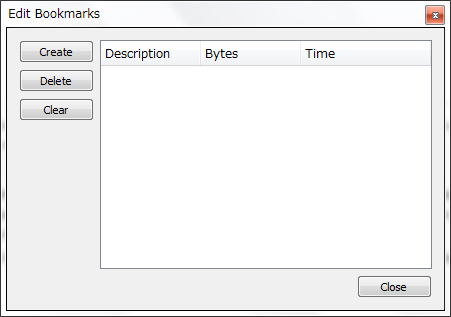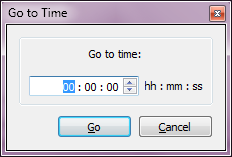Documentation:Playback
VLC media player helps you to create media files. After creating media files, the quality has to be tested. You can test the quality and several other parameters using playback. In playback, you can specify parameters such as time, bookmarks, and titles.
Bookmarks
You can mark and locate particular places in an audio or video file using the Bookmarks feature of VLC. If you want to view a particular scene in a movie or listen to certain tune in a song repeatedly, you can create bookmarks.
To bookmark a scene in a video:
- From the Playback menu select the Bookmarks option, and the Manage Bookmarks. The Edit Bookmarks dialog box opens.
- Click Create to create a bookmark for the current track. The created bookmark appears in the Edit Bookmarks dialog box.
- To view a scene that is bookmarked, select a bookmark from Bookmarks in the Playback menu.
Edit Bookmarks dialog box under Windows in VLC 1.1.5
Title
In a DVD format, each movie is referred to by its title or name. A title is displayed whenever a movie is played by any media player. You can view all titles in a folder in a sequential manner.
- To open a folder, select Open Folder from the Media menu. Locate the folder in which the video files are present and click OK.
- To select a title, click Title in the Playback menu. The selected title is then played.
Chapter
A video is divided into chapters. Different chapters can be accessed at random in a video which is being played. Using this option, you can directly view your favourite chapter without having to see the complete video.
To play a chapter:
- Select Open Folder from the Media menu.
- Locate the folder in which the video files are present.
- Select a video file and click OK.
The file is played in the VLC media player.
- Select Chapter in the Playback menu to view the list of chapters. Select a chapter of your choice.
Then selected chapter is played.
In VLC, you can navigate to different titles and their corresponding chapters. You can also customise a DVD by selecting options such as subtitle, angle and so on.
- To customize a title, select the required option from DVD Menu in the Navigation menu.
- To view a title, select a Title under Navigation in the Playback menu. The selected title is played.
- To view a chapter in a title, select Title. When you select a title, the chapters in a title are listed. Select a chapter.
Refer to Title and Chapter sections for more details.
Program
This option is enabled only if streams of format DVB and TS are played. Choose the program to select by giving its Service ID. Only use this option if you want to read a multi-program stream (like DVB streams for example). Description needs to be improved
Specify the time
This option is used to go to a specific frame in a media file and listen or view once again.
- To specify time select Jump to Specific Time from the Playback menu. The Go to Time dialog box is displayed.
- Enter the time in hh:mm:ss.
- Click on the Go button. The control moves the tracker to a specific frame and the media file continues from that specified frame.
- Click Cancel to exit the dialog box.
Note: Ensure that time limit is within the range of length of the media file.
Please read the Documentation Editing Guidelines before you edit the documentation

